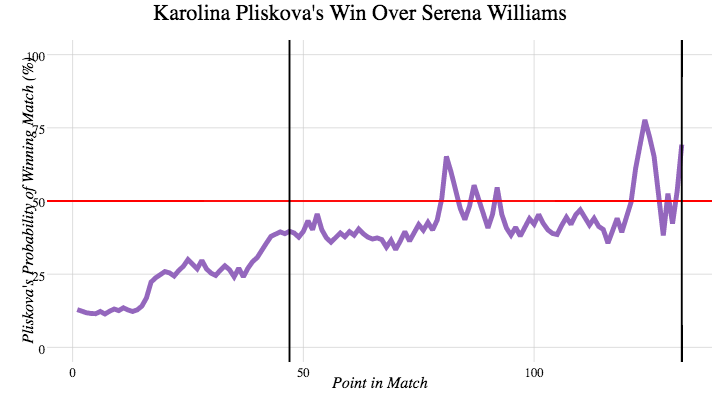Karolina Pliskova sprung one of the upsets of the year when she downed Serena Williams in straight sets in Thursday’s US Open semifinal. Going in to the match Pliskova had just a 13% win probability, so how and when did she turn this around? Stephanie Kovalchik from Tennis Australia’s Game Insight Group (GIG) crunched the numbers to analyse the key turning points in the match.
On Day 11, only Karolina Pliskova stood in the way of Serena Williams road to what has seemed like an inevitable 23rd Major victory. Pre-match predictions for the match were giving Pliskova just a 13% chance of pulling out an upset. But after Pliskova’s thrashing of Ana Konjuh, even Williams had to have some doubt about the semifinal outcome.
The first turning point and sign of things to come came in the first set and third game, when Pliskova was the first to break serve. That break added ten percentage points to Pliskova’s win chances. The next critical moment was in the fifth game when Pliskova created another break chance but failed to convert. Holding her serve, she kept on the attack in the seventh, breaking Williams at love. The set was in Pliskova’s hands at that point and her win chances for the match were at a high of 40%.

Looking at the point-to-point win chances for Pliskova, it is really interesting to see that, although there is a gradual increase in her favor (especially over the first set), there were only a few occasions when she was in a dominant position, probabilistically. Even after winning the first set, her chances of winning the match hovered between 40-45% for most of the second. Watching the match, it was clear that Pliskova had the upperhand and was perhaps helped by a not entirely healthy Williams. Still, Williams overall win record gave her good chances of turning things around up until the very end.
The match might have gone very differently if Pliskova had been able to hold her serve after winning the first break in the fifth game of the second set. After that, both players save break points to stay on serve and force a tiebreak to decide the set and, possibly, match.
At the first point of the tiebreak, the win chances were dead even. Pliskova took the early advantage with the first point meaning break, at that point her win chances soared to 61%, and, after holding her next 2 service points, hit a match-high of 78%. But Williams wasn’t going to let the match slip away that easily. She won the next 4 points and dropped Pliskova’s upset prospects back to 40%. Pliskova had to act quickly and dig deep to get another mini-break to square her chances again. With both players back on serve, it would be the first to get the next break that could take the whole thing. In the end, it was Pliskova who turned her nose at the odds and beat Williams to the win.
17 August 2017
Alicia Molik, a former top 10 star who owned one of the sport’s best serves, believes se... More
24 February 2017
It is no coincidence that some of the best singles players to ever pick up a racquet all h... More
8 June 2016
Transitioning between surfaces can be one of the biggest challenges in the game. Understan... More
21 February 2017
Tennis elbow is a condition that can affect more than those people who play tennis – and... More